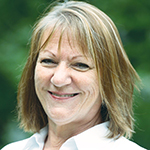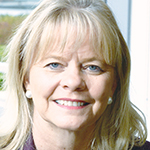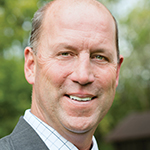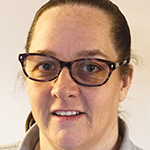By PATRICIA CORRIGAN
When a first responder or social services provider in Baltimore suspects a person they are aiding is the victim of human trafficking, they have the ability to call in a "blue dot incident" and arrange for a "warm handoff" to a nurse trained in forensic exams and caring for victims of crimes and trauma.

Photo illustration/Shutterstock
Mercy Medical Center in Baltimore has a roster of some 30 forensic nurses who are available around the clock to travel to all 11 hospitals in the city to meet with victims of interpersonal violence, including sex or labor trafficking. Many of the nurses are employed by other hospitals and work on a per diem basis with Mercy Medical Center to perform forensic exams.
Baltimore is a hotspot for human trafficking and the COVID-19 pandemic did not drastically decrease the number of patients identified as trafficking victims, said Debra S. Holbrook, the director of forensic nursing at Mercy. From April through mid-July last year, the hospital's forensic nurses responded to 20 blue dot incident calls.

Holbrook
The nurses offer empathy as they collect evidence following strict chain of command protocols to ensure admissibility in criminal prosecution. They provide general medical care including prophylaxis for disease for patients who have been trafficked for sex. A case manager may meet with a trafficking victim to make sure he or she has food, a shower, and a safe place to sleep at a location unknown to the trafficker. While the case manager also can help arrange treatment for drug dependency, the emotional and physical damage resulting from trafficking may be long-lasting.
"Human trafficking, for sex or labor, is ugly and it's tragic, and those victimized by it suffer from the experience across their entire life," Holbrook said. The stand-alone hospital coordinates care for all victims of interpersonal violence in the Baltimore area including military personnel.
"Trafficking is modern-day slavery, and it's the second biggest criminal industry in the world, a $50 billion business in 2015," she said.
Breaking down silos
Holbrook chairs the medical subcommittee of the Baltimore City Human Trafficking Collaborative. Founded in 2017, it operates under the auspices of the Mayor's Office of Neighborhood Safety and Engagement. The collaborative is made up of representatives from 45 agencies, including city and state government offices, health care professions, law enforcement, the fire department, the judiciary, prosecutors, public defenders, survivors' groups and numerous organizations that provide support to them.
The collaborative is charged with raising awareness of human trafficking, especially among people who may be in a position to intervene. It does this through education, law enforcement training and the media. It supports prosecutions of traffickers and takes a victim-centered, trauma-informed approach to caring for victims.
"We don't have much else in common, but we all interface in the criminal justice system," Holbrook said. "We've embraced the mindset that we're going to work together, rather than in our respective silos, and we are being open enough and humble enough to ask how we can fix the problem. The collaborative is brilliantly designed, and it's effective," she said, adding that a research study will be launched soon to determine how victims of trafficking aided by the collaborative are faring.
Mercy first offered its anti-human trafficking training program in 2007. Called the Blue Dot Initiative, its goal was to teach staff members to recognize victims of trafficking and intervene. Eight years later, the hospital launched a pilot program to help other Baltimore-area hospitals identify the telltale signs of trafficking that are often overlooked. (See sidebar.)
Since March 2020, Mercy Medical Center's forensic nurses have met with more than 100 victims of human trafficking. "That may not sound like many, but it's huge, because most cities are helping maybe 10 to 12 people a year," Holbrook said. "One of Mercy's missions is to take care of the most vulnerable, and if we missed this, we'd be missing one of the most vulnerable populations."
Blinders off
Susan Finlayson, Mercy Medical Center's senior vice president of operations, said, "Deb's team is committed and innovative, working to provide victims with compassion, dignity and justice, and helping them to move on to another path."

Finlayson
"Our hospital is small but mighty, and we don't try to be all things to everybody," Finlayson continued. Since its founding almost 150 years ago, Mercy Medical Center has stayed true to the mission of the Venerable Catherine McAuley, foundress of the Sisters of Mercy, to care for the sick no matter the circumstances. "Taking care of trafficked individuals throughout the city is part of being a good community health care partner," Finlayson said.

Stack
No other major city has a coordinated program as broad as Baltimore's human trafficking response, said Thomas Stack, human trafficking coordinator for the Mayor's Office of Neighborhood Safety and Engagement. He co-founded the collaborative with Baltimore City Councilman Kristerfer Burnett, and together they serve as co-chairs. Stack and Holbrook often share the stage at conferences, educational programs and events held to raise awareness about trafficking, and other cities now seek advice from the collaborative on mounting an effective,
victim-centered response.
"We're all really proud of what we've done here — when it comes to fighting human trafficking, Baltimore is rocking and rolling," Stack said. "Out of 100 people that show signs of being trafficked, only two or three may let us help right away, but as Deb always says, we must plant the seed. I say you can lead a horse to water and though that horse may not drink, eventually it will get thirsty. In Baltimore, we always have water."

Lull
Because victims typically avoid eye contact and are not forthcoming about their situation when speaking with authorities, recognizing the signs of human trafficking requires training. Lt. Colleen Lull, who sits on the collaborative's medical subcommittee with Holbrook, works at the Baltimore City Fire Department's Emergency Medical Service Training Academy, where she oversees continuing education and certification for paramedics. Lull incorporates information on human trafficking in her training programs, and her counterpart does the same in classes for Baltimore's emergency medical technicians.
"I start with stereotypes versus the reality, discussing preconceptions about what people think prostitution is, for example as portrayed in the film Pretty Woman, and what it really is," Lull said. "Most prostitution is pimp-controlled, through force, fraud or coercion — and that makes it trafficking. These women are not making voluntary choices and they are not in control of their lives. Plus, I always point out that the average age of entry into the life is between 11 and 14. Children are being lured in and they do not have a path out."
Easy does it
Lull also teaches paramedics what else to look for when out on calls with firefighters or ambulance crews: Poor living conditions with multiple people in a crowded space, few furnishings and a lack of personal possessions. "Every time we have the class, someone remarks that they have seen all that, but didn't know what it was," Lull said.
Because victims of trafficking have been taught to fear police, but not firefighters, sometimes paramedics and EMTs out on a call can start a quiet conversation with a trafficked individual who may eventually agree to meet with a forensic nurse. Lull said for that reason, she teaches effective interview techniques.
"You have to slow everything down and speak in a reassuring tone, with no direct questions, or the victim will shut you down," she said. "When you offer help, you want to explain that the victim will make choices from the available options. That gives them back some control."
Lull added, "This is a whole new way of saving people's lives."
Trafficking victims keep mum to protect themselves
The Polaris Project, which operates the National Human Trafficking Hotline, reports that the number of people being trafficked worldwide for sex or labor is estimated to be 25 million. With a population of about 2.3 million, Baltimore is considered a hotspot because of its size and also its proximity to Washington, D.C., which routinely tops lists of most cases per capita of human trafficking.
In the U.S., in addition to sex workers, victims may include hotel workers, gardeners, landscapers, produce pickers and employees at nail salons, massage parlors, strip clubs or hair salons. Elderly individuals may be trafficked by people who steal their financial benefits.
It's rare that an individual will voluntarily identify themselves as a victim of human trafficking when they are talking to a health provider or a first responder, said Debra S. Holbrook, the director of forensic nursing at Mercy Medical Center in Baltimore.
"When asked a screening question, they won't answer because they've been taught to distrust almost everyone." They fear if they tell anybody anything, their captor or pimp will beat, starve or torture them or withhold drugs, shelter or sleep. In some cases trafficking victims may have reason to fear that by speaking to authorities, they will put family members at risk.
It's common for victims who require medical attention to be accompanied by a trafficker who handles all the paperwork and does all the talking. Victims who do respond to a caregiver's question about their safety and well-being may sound rehearsed. Trafficking victims may be malnourished or sleep-deprived. They may have scars or bruises in various stages of healing, sexually transmitted infections or symptoms of drug withdrawal.
"For all of us working in Baltimore to help victims, our reward is when we are able to help someone get out of the life and onto a different path," Holbrook said.
— PATRICIA CORRIGAN